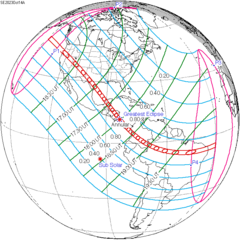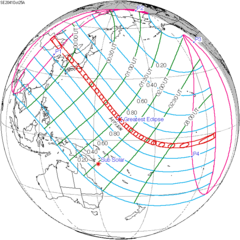| Total eclipse | |||||||||||||||||
 The Moon's hourly motion shown right to left The Moon's hourly motion shown right to left | |||||||||||||||||
| Date | October 18, 2032 | ||||||||||||||||
|---|---|---|---|---|---|---|---|---|---|---|---|---|---|---|---|---|---|
| Gamma | 0.4169 | ||||||||||||||||
| Magnitude | 1.1039 | ||||||||||||||||
| Saros cycle | 127 (43 of 72) | ||||||||||||||||
| Totality | 47 minutes, 6 seconds | ||||||||||||||||
| Partiality | 195 minutes, 54 seconds | ||||||||||||||||
| Penumbral | 315 minutes, 24 seconds | ||||||||||||||||
| |||||||||||||||||
| ← April 2032April 2033 → | |||||||||||||||||
A total lunar eclipse will occur at the Moon’s descending node of orbit on Monday, October 18, 2032, with an umbral magnitude of 1.1039. A lunar eclipse occurs when the Moon moves into the Earth's shadow, causing the Moon to be darkened. A total lunar eclipse occurs when the Moon's near side entirely passes into the Earth's umbral shadow. Unlike a solar eclipse, which can only be viewed from a relatively small area of the world, a lunar eclipse may be viewed from anywhere on the night side of Earth. A total lunar eclipse can last up to nearly two hours, while a total solar eclipse lasts only a few minutes at any given place, because the Moon's shadow is smaller. Occurring about 2.1 days after perigee (on October 16, 2032, at 17:25 UTC), the Moon's apparent diameter will be larger.
This lunar eclipse is the second of a tetrad, with four total lunar eclipses in series, the others being on April 25, 2032; April 14, 2033; and October 8, 2033.
Visibility
The eclipse will be completely visible over east Africa, Europe, and Asia, seen rising over west Africa and eastern South America and setting over Australia and the western Pacific Ocean.
 
|
Eclipse details
Shown below is a table displaying details about this particular solar eclipse. It describes various parameters pertaining to this eclipse.
| Parameter | Value |
|---|---|
| Penumbral Magnitude | 2.08413 |
| Umbral Magnitude | 1.10390 |
| Gamma | 0.41692 |
| Sun Right Ascension | 13h36m15.4s |
| Sun Declination | -10°01'20.8" |
| Sun Semi-Diameter | 16'03.4" |
| Sun Equatorial Horizontal Parallax | 08.8" |
| Moon Right Ascension | 01h35m47.9s |
| Moon Declination | +10°25'28.7" |
| Moon Semi-Diameter | 16'22.8" |
| Moon Equatorial Horizontal Parallax | 1°00'07.0" |
| ΔT | 75.3 s |
Eclipse season
See also: Eclipse cycleThis eclipse is part of an eclipse season, a period, roughly every six months, when eclipses occur. Only two (or occasionally three) eclipse seasons occur each year, and each season lasts about 35 days and repeats just short of six months (173 days) later; thus two full eclipse seasons always occur each year. Either two or three eclipses happen each eclipse season. In the sequence below, each eclipse is separated by a fortnight.
| October 18 Descending node (full moon) |
November 3 Ascending node (new moon) |
|---|---|
 |

|
| Total lunar eclipse Lunar Saros 127 |
Partial solar eclipse Solar Saros 153 |
Related eclipses
Eclipses in 2032
- A total lunar eclipse on April 25.
- An annular solar eclipse on May 9.
- A total lunar eclipse on October 18.
- A partial solar eclipse on November 3.
Metonic
- Preceded by: Lunar eclipse of December 31, 2028
- Followed by: Lunar eclipse of August 7, 2036
Tzolkinex
- Preceded by: Lunar eclipse of September 7, 2025
- Followed by: Lunar eclipse of November 30, 2039
Half-Saros
- Preceded by: Solar eclipse of October 14, 2023
- Followed by: Solar eclipse of October 25, 2041
Tritos
- Preceded by: Lunar eclipse of November 19, 2021
- Followed by: Lunar eclipse of September 19, 2043
Lunar Saros 127
- Preceded by: Lunar eclipse of October 8, 2014
- Followed by: Lunar eclipse of October 30, 2050
Inex
- Preceded by: Lunar eclipse of November 9, 2003
- Followed by: Lunar eclipse of September 29, 2061
Triad
- Preceded by: Lunar eclipse of December 19, 1945
- Followed by: Lunar eclipse of August 20, 2119
Lunar eclipses of 2031–2034
| Ascending node | Descending node | |||||
|---|---|---|---|---|---|---|
| Saros | Date Viewing |
Type Chart |
Saros | Date Viewing |
Type Chart | |
| 112 | 2031 May 07
|
Penumbral
|
117 | 2031 Oct 30
|
Penumbral
| |
| 122 | 2032 Apr 25
|
Total
|
127 | 2032 Oct 18
|
Total
| |
| 132 | 2033 Apr 14
|
Total
|
137 | 2033 Oct 08
|
Total
| |
| 142 | 2034 Apr 03
|
Penumbral
|
147 | 2034 Sep 28
|
Partial
| |
| Last set | 2031 Jun 05 | Last set | 2030 Dec 09 | |||
| Next set | 2035 Feb 22 | Next set | 2035 Aug 19 | |||
Tritos series
The tritos series repeats 31 days short of 11 years at alternating nodes. Sequential events have incremental Saros cycle indices.
This series produces 20 total eclipses between April 24, 1967 and August 11, 2185, only being partial on November 19, 2021.
| Tritos eclipse series (subset 1901–2087) | ||||||
|---|---|---|---|---|---|---|
| Descending node | Ascending node | |||||
| Saros | Date Viewing |
Type chart |
Saros | Date Viewing |
Type chart | |
| 115 | 1901 Oct 27
|
Partial
|
116 | 1912 Sep 26
|
Partial
| |
| 117 | 1923 Aug 26
|
Partial
|
118 | 1934 Jul 26
|
Partial
| |
| 119 | 1945 Jun 25
|
Partial
|
120 | 1956 May 24
|
Partial
| |
| 121 | 1967 Apr 24
|
Total
|
122 | 1978 Mar 24
|
Total
| |
| 123 | 1989 Feb 20
|
Total
|
124 | 2000 Jan 21
|
Total
| |
| 125 | 2010 Dec 21
|
Total
|
126 | 2021 Nov 19
|
Partial
| |
| 127 | 2032 Oct 18
|
Total
|
128 | 2043 Sep 19
|
Total
| |
| 129 | 2054 Aug 18
|
Total
|
130 | 2065 Jul 17
|
Total
| |
| 131 | 2076 Jun 17
|
Total
|
132 | 2087 May 17
|
Total
| |
| 133 | 2098 Apr 15
|
Total
| ||||
Saros 127
Lunar saros series 127, repeating every 18 years and 11 days, has a total of 72 lunar eclipse events including 54 umbral lunar eclipses (38 partial lunar eclipses and 16 total lunar eclipses). Solar Saros 134 interleaves with this lunar saros with an event occurring every 9 years 5 days alternating between each saros series.
| Greatest | First | |||
|---|---|---|---|---|
The greatest eclipse of the series occurred on 1888 Jul 23, lasting 102 minutes. |
Penumbral | Partial | Total | Central |
| 1275 Jul 09 | 1473 Nov 04 | 1798 May 29 | 1834 Jun 21 | |
| Last | ||||
| Central | Total | Partial | Penumbral | |
| 1960 Sep 05 | 2068 Nov 09 | 2429 Jun 17 | 2555 Sep 02 | |
| 1906 Aug 04 | 1924 Aug 14 | 1942 Aug 26 | |||

|

|

|

|

|

|
| 1960 Sep 05 | 1978 Sep 16 | 1996 Sep 27 | |||

|

|

|

|

|

|
| 2014 Oct 08 | 2032 Oct 18 | 2050 Oct 30 | |||

|

|

|

|

|

|
| 2068 Nov 09 | |||||

|

| ||||
Half-Saros cycle
A lunar eclipse will be preceded and followed by solar eclipses by 9 years and 5.5 days (a half saros). This lunar eclipse is related to two partial solar eclipses of Solar Saros 134.
| October 14, 2023 | October 25, 2041 |
|---|---|

|

|
See also
Notes
- "October 18–19, 2032 Total Lunar Eclipse (Blood Moon)". timeanddate. Retrieved 21 November 2024.
- "Moon Distances for London, United Kingdom, England". timeanddate. Retrieved 21 November 2024.
- "Total Lunar Eclipse of 2032 Oct 18" (PDF). NASA. Retrieved 21 November 2024.
- "Total Lunar Eclipse of 2032 Oct 18". EclipseWise.com. Retrieved 21 November 2024.
- Mathematical Astronomy Morsels, Jean Meeus, p.110, Chapter 18, The half-saros
External links
- 2032 Oct 18 chart: Eclipse Predictions by Fred Espenak, NASA/GSFC
This lunar eclipse-related article is a stub. You can help Misplaced Pages by expanding it. |


